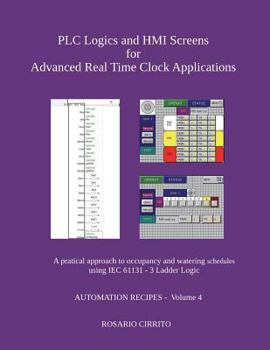Plc Logics and Hmi Screens for Advanced Real Time Clock Automation: A Pratical Approach to Occupancy and Watering Schedule Using Iec 61131 - 3 Ladder Logic
This booklet is the fourth of a series dedicated to automation recipes created with the PLC (Programmable Logic Controller) and HMI (Human Machine Interface) binomial. The series is aimed at an audience of readers with an elementary knowledge of PLC programming, eager to learn advanced solutions, extensively tested on real systems. In modern computer programming, generally oriented to the development of "object-oriented" software, the developer strives, as much as possible, to resort to so-called "Design Patterns", standard solutions for frequently recurring problems. A design pattern describes a problem, particularly recurring in a given context, and then provide the heart of the solution to this problem. It is therefore possible to successfully reuse this solution, thousands and thousands of times, with the certainty of using an efficient and well-tested solution. In the present series, which deals exclusively with development on PLC-HMI, the term "design pattern" has been replaced by the term "automation recipe" for an easier understanding by the non IT reader. This fourth notebook deals exhaustively with management strategies based on the internal calendar clock of the PLC. The latter, in fact, allows you to easily generate triggers in coincidence of time intervals corresponding to every minute, every 5 minutes, every quarter of an hour, every hour, every day, every month, every year. These triggers are made available to other application program routines in order to schedule totalization or reporting activities on an hourly, daily, monthly and yearly basis. The system variable "day of the week" also allows you to manage differentiated control logics, depending on whether the day in question is between the working days from Monday to Friday, or Saturday rather than Sunday. Within the day, differentiated time intervals can be configured. This possibility is very important for smart electricity management systems in multi-hour tariffs. Occupation tables are typically used to manage the start / stop of air conditioning systems in the residential building sector. Extending the concept of the occupancy schedule it is possible to use the same logic for starting / stopping of the refrigeration system at times of particular loading / unloading of product in the cold rooms. Likewise, this type of logic can also be used to manage the duration and frequency of watering both within the day and the week. This type of recipe therefore has a general use, somehow "transversal" to the various types of technological systems. We can conclude that any type of management and accounting of both electric and thermal energies can not do without the temporal triggers offered by the RTC (Real Time Clock) subroutine. In detail, the first section of this notebook, dedicated to the application domain, illustrates the date clock and the employment or watering tables. The second section deals with the development of combined software for both PLC and HMI. The logic of the RTC (Real Time Clock) subroutine and that of the functional blocks (UDFB), TimeValidator, Load1Enable, Load3Enable, DayOfWeekValidator and Watering are illustrated, along with the relative display screens, local monitoring and configuration parameter settings. Finally, the third chapter shows the application of the concepts developed in a real case of control of an irrigation system. All the logics, published in the book, have been developed using the IEC61131-3 compliant Ladder language; therefore it is extremely easy to migrate them on almost all the PLCs of other manufacturers. The same applies to HMI screens whose graphic controls are very similar on the different equipment offered on the market. The reader who already has experience with other manufacturers' equipment can therefore continue to use what he knows best.
Format:Paperback
Language:English
ISBN:1980718776
ISBN13:9781980718772
Release Date:April 2018
Publisher:Independently Published
Length:50 Pages
Weight:0.41 lbs.
Dimensions:0.1" x 8.5" x 11.0"
Customer Reviews
0 rating





